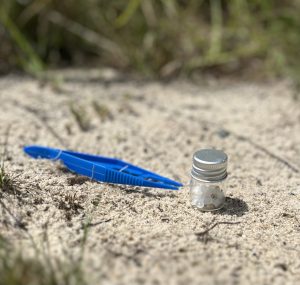
Nurdles are small plastic pellets, seen here in the glass vial, are the raw material used to create everything plastic. They are often dispersed during transport and end up in waterways and oceans. Volunteers can help collect data by conducting 10-minute surveys of the beaches.
By Cindy Hoffman, Staff Writer
(Aug. 17, 2023) What the heck is a nurdle?
A nurdle is a small plastic pellet that is the raw material used to create virtually all plastic products.
The pellets are made and shipped all over the world to manufacturers to make anything from water bottles to sunglasses to medical equipment to car parts.
Nurdles are small — about 5 mm or the size of a BB — and because of that, some can spill into the environment from trucks, trains and ships and other freight carriers. From there, they wash up on our beaches by the millions.
The Maryland Coastal Bays Program (MCBP) has joined the NurdlePatrol.org campaign to track and remove nurdles from this coastline.
“We are in our first phase of determining if there is a nurdle issue locally,” Liz Wist, the education coordinator for Maryland Coastal Bays Program (MCBP), said.
The Nurdle Patrol started in Texas in 2018 after a large number of plastic pellets washed up on Mustang and North Padre Islands. The project has expanded across the nation since.
“By becoming part of the Nurdle Patrol community science program, you are helping add to the bigger picture about where nurdles have ended up, all while bringing awareness about the impacts of plastic pollution,” Wist said.
Volunteers can do this on their own after watching an online training. After conducting a survey, they can submit their findings into the NurdlePatrol.org database to be part of the national survey.
The best thing about this, besides helping the environment, is anyone can do it anytime and each survey only takes 10 minutes.
The basic process is this. Go to the newest high tide line at the beach, bay or other water body and look for small plastic pellets.
They are small, so bending over or getting on your knees is the best way to look. Once you find one, start your timer for 10 minutes.
Then go to the next high tide line and look for pellets. After 10 minutes, stop the clock and submit the findings to NurdlePatrol.org. Even if no nurdles are found, that is a data point that can be submitted.
Data includes information on location, amount collected, length of collection time, and number of volunteers involved.
Data from all over the country is being reported through this website.
Nurdles need to be disposed of properly after collection. Simply put, this means throwing them out in a lined trash can.
Anyone of any age can participate in a nurdle survey.
MCBP provides all the materials needed to conduct nurdle surveys.
The materials include tweezers, a glass vial, instructions and a carrying bag, which can be picked up at the MCBP office during office hours at 8219 Stephen Decatur Hwy in Berlin.
To schedule a pick-up time for materials, contact Gregg Atkin at gatkin@mdcoastalbays.org
